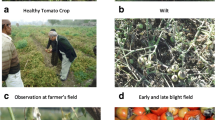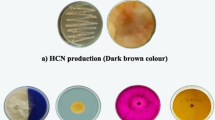Abstract
Field surveys undertaken in major tomato growing districts of the Karnataka state, located in southern part of India, revealed a high incidence of bacterial wilt caused by Ralstonia solanacearum and it is one of the most destructive bacterial diseases of economically important crops. Across all the tomato cultivars under evaluation, the disease incidence in plants ranged from 9% to 39% whereas the incidence in seeds ranged from 4% to 18%. The effects of tomato seed treatments with Pseudomonas fluorescens in the control of bacterial wilt under greenhouse conditions revealed that the treatments protected plants against soil-borne infections of the bacterial wilt organism. Seed treatment with antagonistic P. fluorescens strain significantly improved the quality of seed germination and seedling vigour. The disease incidence was significantly reduced in plants raised from P. fluorescens treated seeds followed by challenge inoculation with R. solanacearum. Periodic field surveys for the incidence of bacterial wilt of tomato could be recommended to monitor the populations of the bacterial wilt pathogen. Workable measures are presented that could lead to the reduction of the prevalence of this serious disease in affected fields of the small farm-holders.


Similar content being viewed by others
References
Abdul Baki AA, Anderson JD (1973) Vigour determination in soybean seed by multiple criteria. Crop Sci 13:630–633
Anand T, Chandrashekaran A, Kuttalam S, Raguchander T, Prakasam V, Samiyappan R (2007) Association of some plant defense activities with systemic resistance to early leaf blight and leaf spot induced in tomato plants by azoxystrobin and Pseudomonas fluorescens. J Plant Interac 2(4):233–244
Angela R, Cruz DELA, Poplawsky AR, Wiese MV (1992) Biological suppression of potato ring rot by fluorescent pseudomonads. Appl Environ Microbiol 58(6):1986–1991
Anith KN, Momol MT, Kloepper JW, Marios J, Olson SM, Jones JB (2004) Efficacy of plant growth-promoting rhizobacteria, acibenzolar-S-methyl and soil amendment for integrated management of bacterial wilt on tomato. Plant Dis 88:669–673
Anuratha CS, Gnanamanickam SS (1990) Biological control of bacterial wilt caused by Pseudomonas solanacearum in India with antagonistic bacteria. Plant Soil 124:109–116
Benhamou N, Belanger RR, Paulitz TC (1996) Induction of differential host responses by Pseudomonas fluorescens in Ri T-DNA transformed pea roots upon challenge with Fusarium oxysporum f. sp. pisi and Pythium ultimum. Phytopathology 86:1174–1185
Carlton WM, Braun EJ, Gleason ML (1998) Ingress of Clavibacter michiganensis sp. michiganensis in tomato leaves through hydathodes. Phytopathology 88(6):525–529
Ciampi-Panno L, Fernandez C, Bustamante P, Andrade N, Ojeda S, Contreras A (1989) Biological control of bacterial wilt of potatoes caused by Pseudomonas solanacearum. Am Potato J 66:315–332
Compant S, Duffy B, Nowak J, Clement C, Barka EA (2005) Use of plant growth-promoting bacteria for biocontrol of plant diseases: principles, mechanisms of action, and future prospects. Appl Environ Microbiol 71(9):4951–4959
Fahy PC, Persley GF (1983) Plant bacterial diseases. A diagnostic guide. Academic Press, London, p 393
Farag NS, Fawzi FG, El-Said SIA, Mikhail MS (1986) Streptomycin in relation to potato brown rot control. Acta Phytopathol Entomol Hung 21:115–122
Food and Agriculture Organization of United Nations, Agriculture data (FAO) (2006) http://www.faostat.com
Graham J, Lloyd AB (1978) An improved indicator plant method for the detection of Pseudomonas solanacearum race 3 in soil. Plant Dis Rep 62:35–37
Granada GA, Sequeira L (1983) A new selective medium for Pseudomonas solanacearum. Plant Dis 67:1084–1088
Hildebrand DC, Senroth MN (1972) Identification of fluorescent pseudomonads. In: The proceedings of the third international conference on plant pathogenic bacteria. Center for Agricultural Publishing and Documentation, Wageningen, pp 281–287
Jayashree K, Shanmugam V, Raguchander T, Ramanathan A, Samiyappan R (2000) Evaluation of Pseudomonas fluorescens (Pf-1) against blackgram and sesame root-rot disease. J Biol Control 14:55–61
Ji P, Campbell HL, Kloepper JW, Jones JB, Suslow TV, Wilson M (2006) Integrated biological control of bacterial speck and spot of tomato under field conditions using foliar biological control agents and plant growth promoting rhizobacteria. Biol Control 36(3):358–367
Kavitha R, Umesha S (2007) Prevalence of bacterial spot of tomato fields of Karnataka and effect of biological seed treatment on disease incidence. Crop Prot 26:991–997
Kelman A (1954) The relationship of pathogenicity in Pseudomonas solanacearum to colony appearance on tetrazolium medium. Phytopathology 64:693–695
King EO, Ward MK, Raney DE (1956) Two simple media for the demonstration of pycoyanin and fluorescein. J Lab Clin Med 4:301–307
Kovacs N (1956) Identification of Pseudomonas pyocyanea by the oxidase reaction. Nature 178:703
Krishnamurthy K, Gnanamanickam SS (1998) Biological control of rice blast by Pseudomonas fluorescens strain Pf7–14: evaluation of a marker gene and formulations. Biol Control 13:158–165
Kuarabachew H, Assefa F, Hiskias Y (2007) Evaluation of Ethiopian isolates of Pseudomons fluorescens as biocontrol agent against potato bacterial wilt caused by Ralstonia (Pseudomonas) solanacearum. Acta Agri Solvenica 90(2):125–135
Leeman M, Van Pelt JA, Den Ouden FM, Heinsbrock M, Bakker PAHM, Schippers B (1995) Induction of systemic resistance against fusarium wilt of radish by lipopolysaccharides of Pseudomonas fluorescens. Phytopathology 85:1021–1027
Lelliott RA, Stead DE (1987) Methods for the diagnosis of bacterial diseases of plants. In: Preece TF (ed) Methods in plant pathology, vol II. Blackwell, Oxford, p 216
Liu QG, Li Z, Tang Z, Zeng XM (1999) Control of tobacco bacterial wilt with antagonistic bacteria and soil amendments. Chin J Biol Control 15:94–95
Lugtenberg BJJ, De Weger AL, Bennet JW (1991) Microbial stimulation of plant growth and protection from disease. Curr Opin Biotechnol 2:457–464
Maurhofer M, Hase C, Meuwly P, Metraux JP, Defago G (1994) Induction of systemic resistance of tobacco to tobacco necrosis virus by root colonizing Pseudomonas fluorescens strain CHA0: influence of the gacA gene and of pyoverdine production. Phytopathology 84:139–146
Mortensen CN (1999) Seed-borne bacterial diseases. Danish Government Institute of seed pathology for developing countries. Hellerup, Copenhagen, pp 86–92
Nandakumar R, Babu S, Viswanathan R, Sheela J, Raguchander T, Samiyappan R (2001) A new bio-formulation containing plant growth promoting rhizobacterial mixture for the management of sheath blight and enhanced grain yield in rice. BioControl 46:493–510
Paul D, Sarma YR (2006) Plant growth promoting rhizobacteria (PGPR)-mediated root proliferation in black pepper (Piper nigrum L.) as evidenced through GS root® software. Arch Phytopathol Plant Prot 39:1–4
Ran LX, Liu CY, Wu GJ, van Loon LC, Bakker PAHM (2005) Suppression of bacterial wilt in Eucalyptus urophylla by fluorescent Pseudomonas spp. in China. Biol Control 32:111–120
Reddy BP, Reddy KRN, Subba Rao M, Rao KS (2008) Efficacy of antimicrobial metabolites of Pseudomonas fluorescens against rice fungal pathogens. Curr Trends Biotech Pharmacy 2(1):178–182
Shakya DD (1993) Occurrence of Pseudomonas solanacearum in tomato seeds imported into Nepal. Bacterial Wilt ACIAR 45:371–372
Smith (1896) Bulletin, Division of Vegetable Physiology and Pathology, USDA No. 12:1–28
Stainer RY, Palleroni NJ, Dondorff M (1966) The aerobic pseudomonads: a taxonomic study. J Gen Microbiol 43:156–271
Sunaina V, Kishore V, Shekhawat GS, Kumar M (1997) Control of potatoes in naturally infested soil by bacterial antagonists. J Plant Dis Prot 104(4):362–369
ISTA (2003) International rules for seed testing. In: Daper (ed) Rules 2003. International Seed Testing Association, Zurich, pp 1–520
Tans-Kersten J, Huang H, Allen C (2001) Ralstonia solanacearum needs motility for invasive virulence on tomato. J Bacteriol 183:3597–3605
Umesha S (2006) Occurrence of bacterial canker in tomato fields of Karnataka and effect of biological seed treatment on disease incidence. Crop Prot 25:375–381
Umesha S, Shylaja MD, Sudheer AS, Krishnappa M, Shetty HS (1998) Biocontrol of downy mildew disease of pearl millet using Pseudomonas fluorescens. Crop Prot 17:387–392
Umesha S, Kavitha R, Shetty HS (2005) Transmission of seed-borne infection of chilli by Burkholderia solanacearum and effect of biological seed treatment on disease incidence. Arch Phytopathol Plant Prot 38(4):281–293
Van Overbeek LS, Cassidy M, Kozdroj J, Trevors JT, Van Elsas JD (2002) A polyphasic approach for studying the interaction between Ralstonia solanacearum and potential control agents in the tomato phytosphere. J Microbiol Methods 48(1):69–86
Van Peer R, Niemann GJ, Schippers B (1991) Induced resistance and phytoalexin accumulation in biological control of fusarium wilt carnation by Pseudomonas sp. strain WCS417r. Phytopathology 81:728–734
Vidhyasekaran P, Rabindran R, Muthamilan M, Nayar K, Rajappan K, Subramanian N, Vasumathi K (1997) Development of a powder formulation of Pseudomonas fluorescens for control of rice blast. Plant Pathol 46(3):291–297
Vidhyasekaran P, Kamala N, Ramanathan A, Rajappan K, Paranidharan V, Velazhahan R (2001) Induction of systemic resistance by Pseudomonas fluorescens Pf1 against Xanthomonas oryzae pvoryzae in rice leaves. Phytoparasitica 29:155–166
Acknowledgement
The present study is the result of research work entitled “Molecular Studies on Bacterial Wilt of Tomato and its Management” awarded by Rajiv Gandhi National Fellowship Scheme, University Grants Commission, Government of India, New Delhi, India.
Author information
Authors and Affiliations
Corresponding author
Additional information
Handling Editor: Monica Hofte.
Rights and permissions
About this article
Cite this article
Vanitha, S.C., Niranjana, S.R., Mortensen, C.N. et al. Bacterial wilt of tomato in Karnataka and its management by Pseudomonas fluorescens . BioControl 54, 685–695 (2009). https://doi.org/10.1007/s10526-009-9217-x
Received:
Accepted:
Published:
Issue Date:
DOI: https://doi.org/10.1007/s10526-009-9217-x




